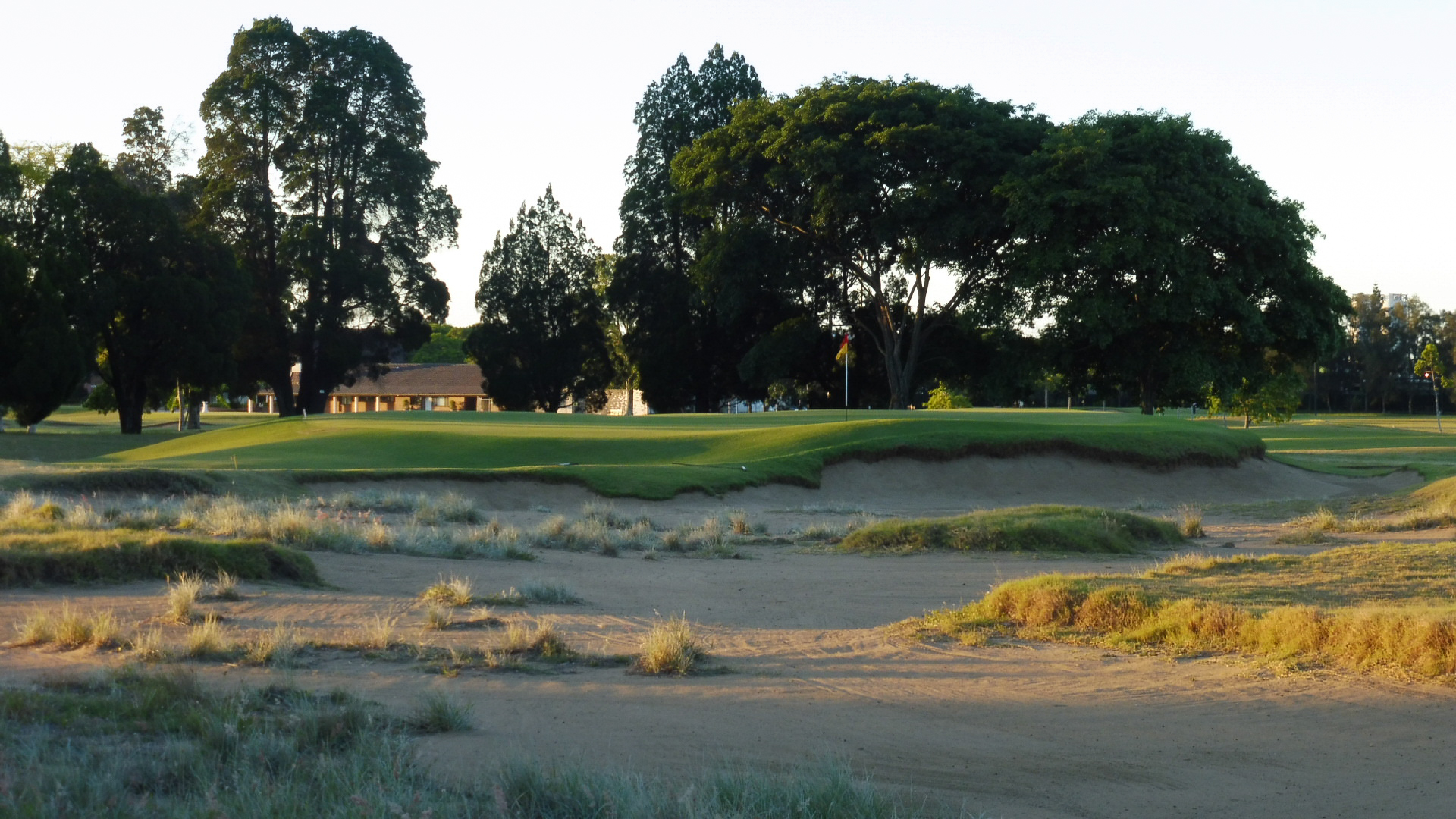
Location: Eagle Farm, QLD
Established: 1920
Architect: Carnegie Clark (1920) & Michael Clayton (2007)
First Played: 23rd June 2012
Last Played: 15th November 2017
Magazine Ratings

29 (Current)

23 (Current)
Whilst in Brisbane to complete the remaining courses on the Top 100 Golf list before heading to Cape Wickham, I decided to revisit Royal Queensland Golf Club. Good decision since the website review was not written after the first time. An interesting fact, this is one of few Royal clubs globally not to be named after the city in which it is located and the only one in this country. It was also the third course in Australia given permission to use the title.
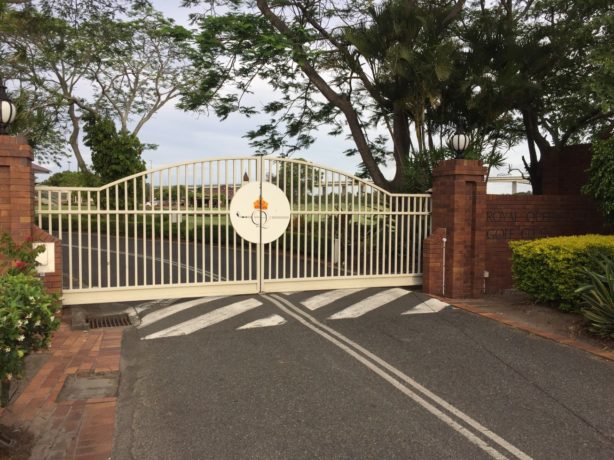
Entrance to Royal Queensland Golf Club (photo credit: ChrisD)
The course was initially designed by founding members in 1920, but club professional Carnegie Clark was commissioned to redesign the course to Championship standard in 1923. He sought advise from Alex Russell, with further advice being given by Dr Alister Mackenzie. In 2007 the club underwent a redesign by Mike Clayton, due to the construction of the Gateway Bridge. Previously the course had gone beyond this point, so temporarily lost 86 acres. Clayton ensured the redesign kept the touches Mackenzie had put in place, with wide fairways on irregular lines, minimal rough and strategic bunkering.
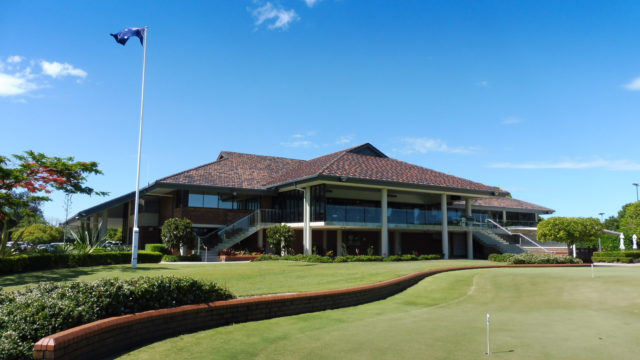
The Clubhouse at Royal Queensland Golf Club
A large double story complex facilitates the clubhouse amenities. A large members bar and wine cellar is on site, with the upstairs balcony allowing a view of four holes. Unfortunately I did not get a chance to visit the locker room to provide an insight.
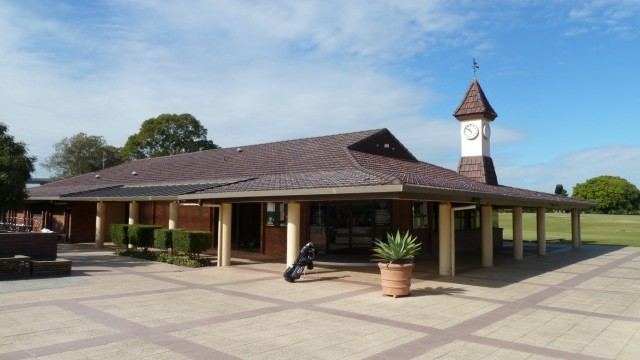
Proshop at Royal Queensland Golf Club
The proshop has its own building and is quite unique in itself. On my original visit the clubhouse was undergoing renovations and barely visible. This made the clock tower on the proshop stand out even more.
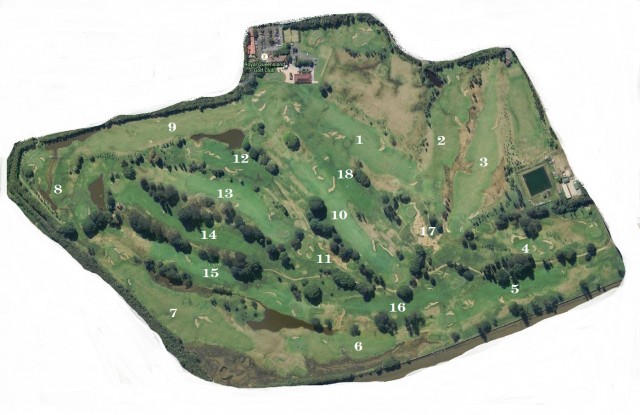
Royal Queensland Golf Club Map
The course is set out on fairly flat land on the banks of the Brisbane River. Previously this mangrove swamp land saw dredging of sand river onto the course. The most easterly part of the course the Gateway Bridge passes overhead. There are open expanses at times, whilst the middle of the course has some tree lined fairways.
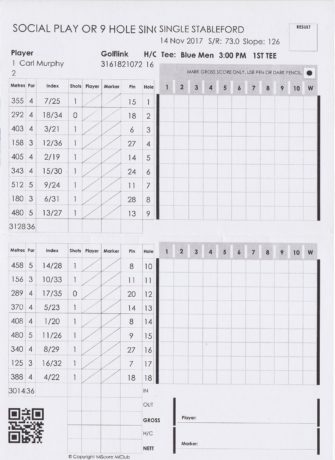
Scorecard for Royal Queensland Golf Club
Since my first visit the score card had changed. Previously what I would have described as the lotto style scorecard, has been replaced by a more traditional style. Interestingly the club publishes distance to the pin, from the front of the green. So note that any measurements on sprinker heads are to the front of the green. What is even better are the use of Golf Renderings by Mike Cocking on the face of the scorecard. This has art depicting the 18th hole with clubhouse and proshop in the background.
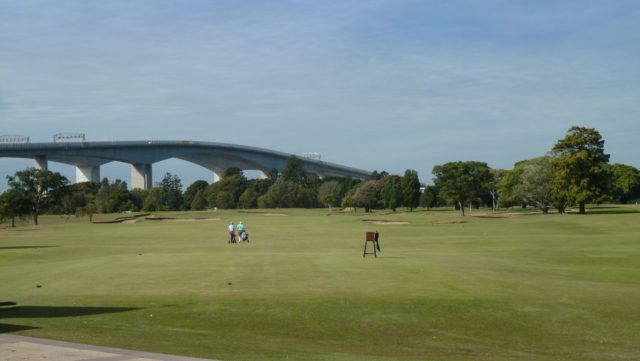
Hole 1 – 355 meter par 4
Starting the round is a medium length par 4 which is quite open on flat terrain. Visually it is not very appealing to be honest, with the Gateway bridge in the background really over shadowing the hole. But it is the design which is excellent. Two sets of bunkers are found on the edges of the fairway. Those on the right closer to the tee, which must be carried for pin positions this side. Another set further up on the left, again the side to play for left pin positions. There is also out of bounds further to the left.
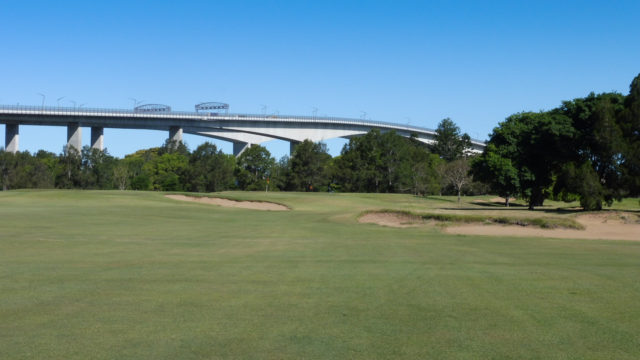
View to the 1st green
So why is play essential to either side depending on pin position. A large bunker built right in the middle of the entrance to the green. This only leaves entry via either side having a clear shot in, taking the bunker slightly out of play. The putting surface itself sits raised above the fairway, so anything not quite hitting the putting surface may run away. There is a lot of short grass on the surrounds, as there are on most holes at Royal Queensland Golf Club, allowing for a variety in shots to recover. This is really simple, yet effective design. Staying with Mike Clayton’s principle, that hitting down the middle of the fairway is boring, it is only playing towards the sides of the fairway and near the hazards, that a reward is given making the approach much easier. Something that will be a theme throughout the round.
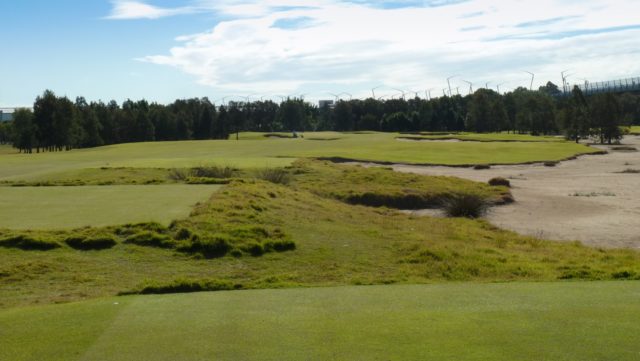
Hole 2 – 292 meter par 4
Next is the shortest and easiest index par 4 at Royal Queensldand Golf Club. Sandy waste runs along the entire right hand side of the hole, protruding into the fairway at times, with these parts treated as bunkers. Another central bunker will ensure some thought goes into the tee shot.
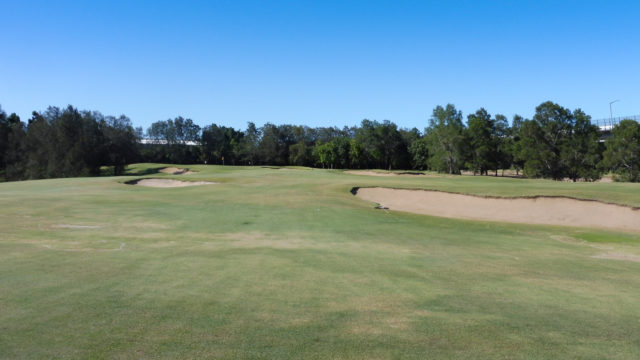
Approach from the 2nd fairway
Playing close to the waste area allows the best angle of attack for most pin positions, as the green angles mostly away to the left in the shape of a Y. This allows a portion back right, which would be best approached from the left of the fairway. The putting surface sits level with the fairway, allowing the ball to run in, but a bunker is located on either side of the green awaits for anything not quite on line. Good short par 4 which requires some thought and offers risk verse reward.
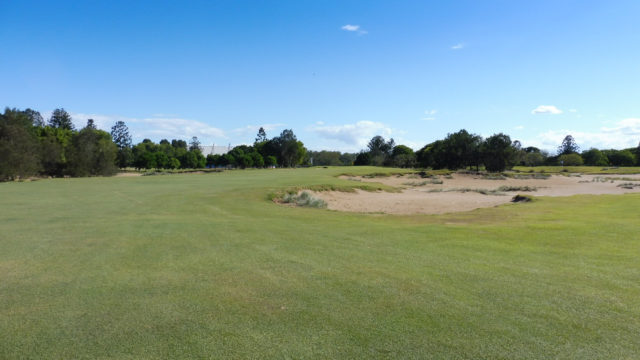
Hole 3 – 400 meter par 4
Heading back in the opposite direction is this long par 4. A waste area runs the entire length on the right (separating holes 2 & 3) and protrudes at driving length. Another waste area is found to the left, but ample room is left to land a shot safely. Ideally the tee shot should be as close to the right hand waste as possible.
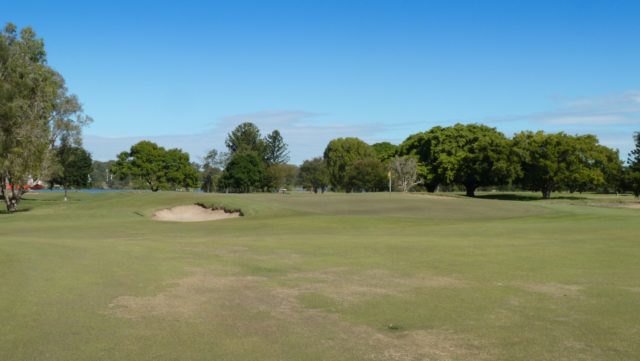
Approach to the 3rd green
Bunkers are found to the left, ensuring they are in play with any approach from this side of the fairway. The putting surface is reasonably long and the entry sits level with the fairway, although the right side slopes away from the green. Another well designed hole which rewards those who take on the risks. The hazards are well placed to ensure some thought goes into each shot.
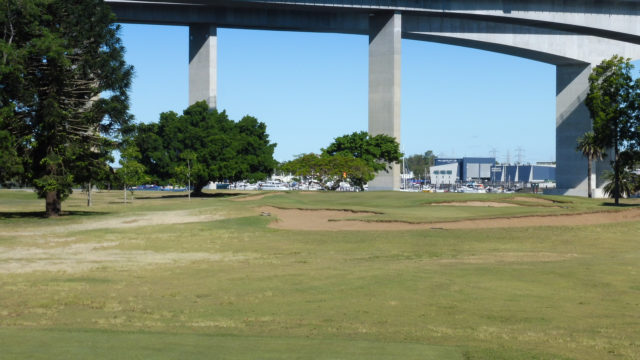
Hole 4 – 160 meter par 3
Coming to the first par 3 of mid length, this is the easiest index hole on the course. A long skinny bunker is placed well short of the green, helping to deceive the distance and the entrance to the hole. The only likely way of landing in this would be from using the putter off the tee.
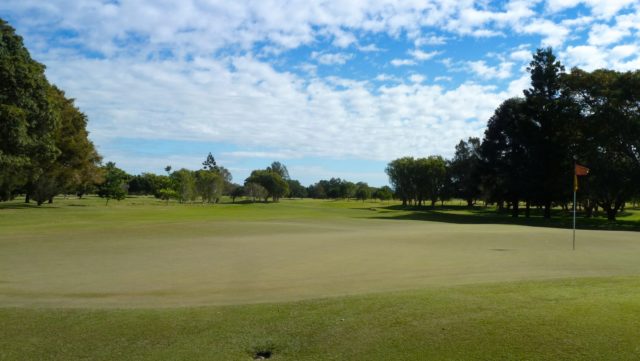
Looking back from the 4th green
Two further traps are located on either side of this long green. Sloping mainly from rear to front, the putting surface also has some slight contours to contend with. Nice testing par 3.
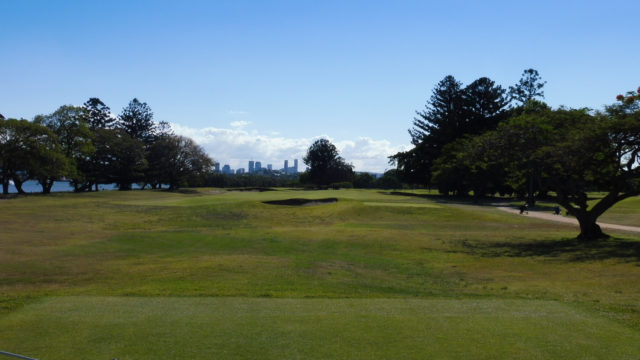
Hole 5 – 405 meter par 4
From the easiest to the hardest hole Royal Queensland Golf Club, this long par 4 runs along the riverbank with a slight turn left. The water is a little distance away, but can still play some affect on the golfers mind. A wide fairway awaits for the safe drive, although playing down the ideal line into the green means being as close to the left bunker as possible, where the fairway tightens
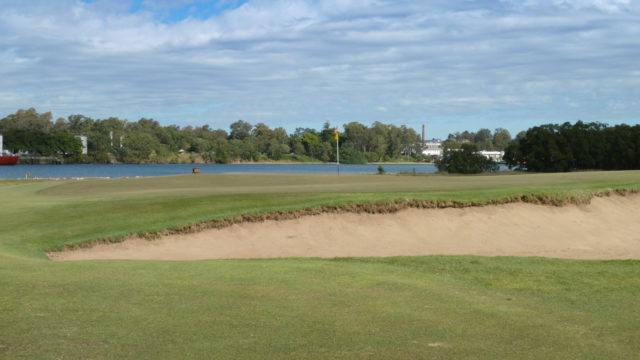
Looking across the 5th green
Play from the right of the fairway will need to carry bunkers to reach the green. The putting surface also slopes slightly from right to left, making shots from the right even more difficult. Although a long hole there is still some distinct strategy required to reduce the difficulty.
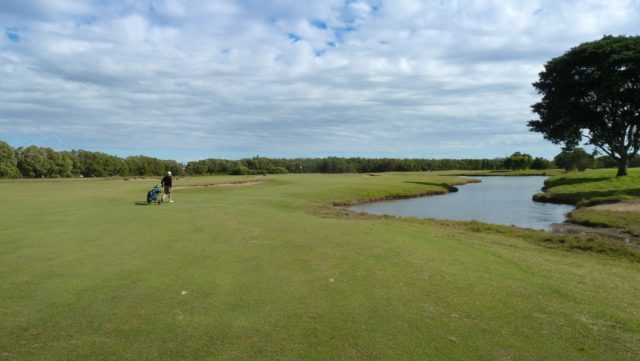
Hole 6 – 343 meter par 4
A mid length par 4 follows with water running down the entire length left, with a couple of inlets running part way across the fairway. This is a tidal area, so it is possible to play the ball out if found. Water starts down the right, across from the first inlet, narrowing the fairway. There is abundant room to layup with a safe tee shot. Those wanting to take on the risk may try to carry the inlet or play the narrow section along the right, which leaves the best angle into the green.
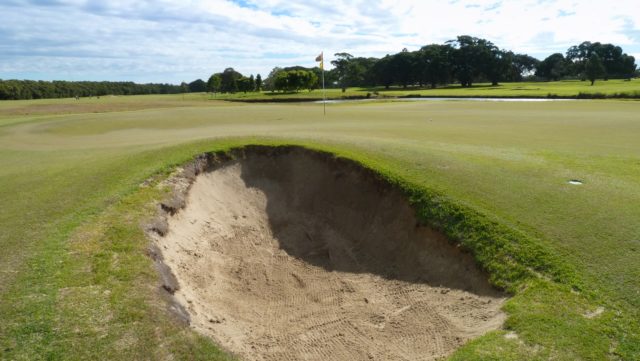
Looking across the 6th green
Avoiding the small pot bunker left of the green, is essential as it will be a difficult recovery, if one can be made. Another longer trap runs down the right side, otherwise the green is fairly open, although does have some gentle slopes surrounding. It might not look much, but this was a good testing hole which allows you to choose your destiny.
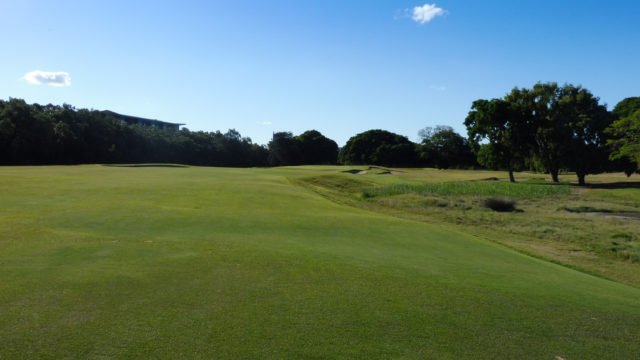
Hole 7 – 512 meter par 5
The longest hole and hardest par 5 at Royal Queensland Golf Club has a gradual turn right. Two central bunkers need to be avoided on this wide fairway. There is a choice to layup or play around, with playing right the riskier option. For the second, wetlands down the right side need to be avoided as the fairway narrows, whilst a bunker sits out on the left.
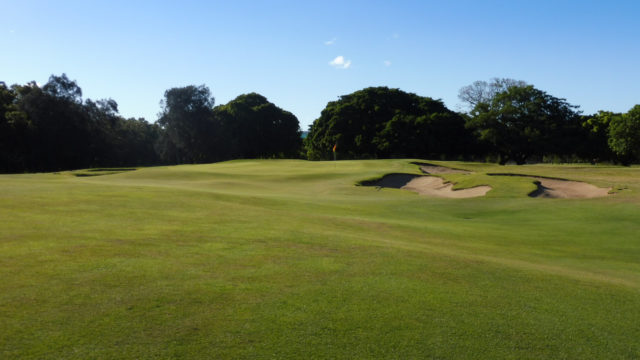
View to the 7th green
A swale runs through before the green, which has two bunkers leading into the green on the right, then further bunkers on either side. There is a large false front which will repel anything short, along with a few contours throughout the green. A good challenge but the first hole where a clear strategy is not visible.
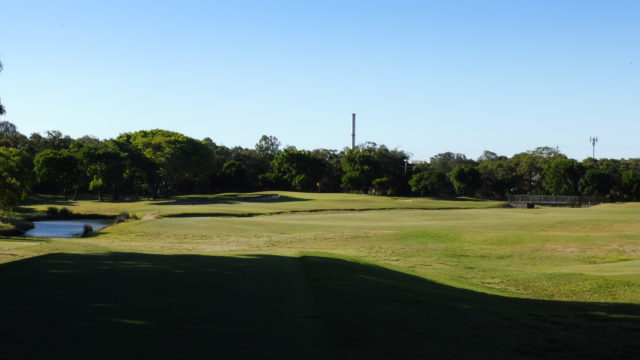
Hole 8 – 182 meter par 3
From the longest par 5, to the longest par 3. The hole plays over a waterway running diagonally across, which can be dry most of the time, so the members told me.
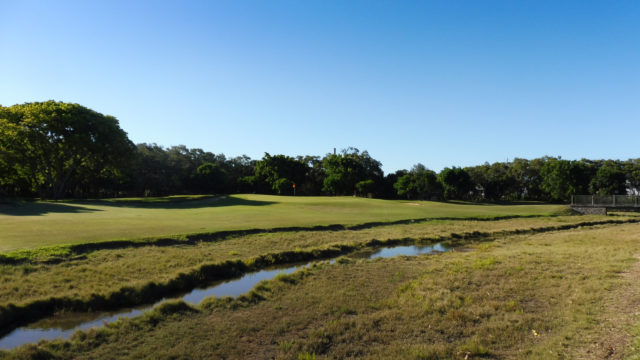
Hazard before the 8th green
A large expanse of short grass is found leading into the green beyond the waterway. Bunkers are located either side of this green which widens towards the rear. This was the first bunker I managed to land in during my second visit. I was quite surprised to find how hard the sand was, with the ball shooting over the green. Good use of land short of the green to allow players of not great length to run the ball in or layup safely. The front of the green is fairly open so allows for a variety of ways getting the ball to the target.
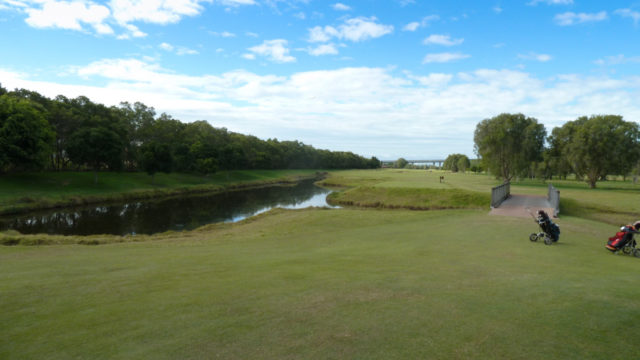
Hole 9 – 479 meter par 5
Finishing the front loop is a mid-long par 5, playing relatively straight. Three bunkers form a triangle at driving distance, one small and central, another small to the right and a long bunker left. Three further bunkers are placed similarly for the second shot, however a narrow lane is left on the right side, with water running alongside.
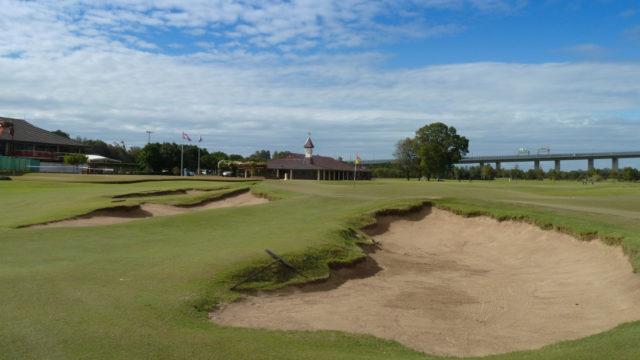
View of the 9th green
Play from the right of the fairway allows a clearer shot into this green, which angles away to the left. A long but narrow putting surface, there are three further traps to the left, with one on the right. Some of these are quite narrow and will require a bit of skill to get out, maybe even play directed away from the hole.
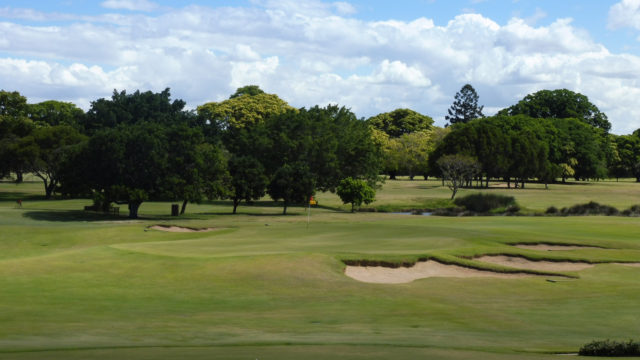
Clubhouse view of the 9th green
Good hole with strategic merit. Really like that a clear line is allowed into the green, but one requiring risk to get there.
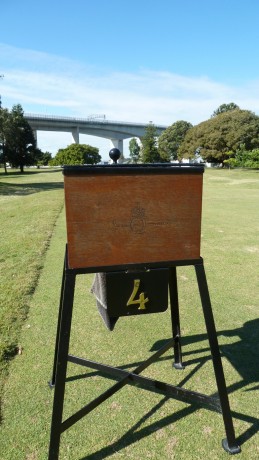
Hole marker
An outstanding feature around the course is the hole markers. These have been made from wood on the grounds and contain a rubbish bin, and sand. Look quite old fashioned, yet really suite the course.
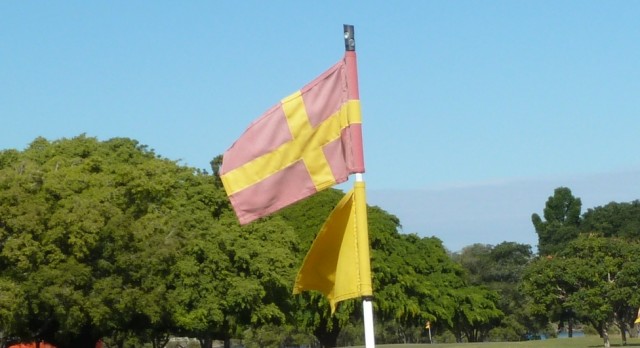
Unusual Pin flag at Royal Queensland Golf Club
I have come across many pin flags playing the top 100 golf courses, but that of Royal Queensland Golf Club has to be the most unusual. Utilising a double flag, one a standard yellow flag, whilst the other is a yellow cross on red background. Thanks to the knowledge of @MarchBankAndrew finally learnt that these are actually nautical flags, spelling ‘RQ’. The yellow cross being R and the plain yellow flag Q. Rather appropriate considering the course sits beside the river with ships passing by daily.
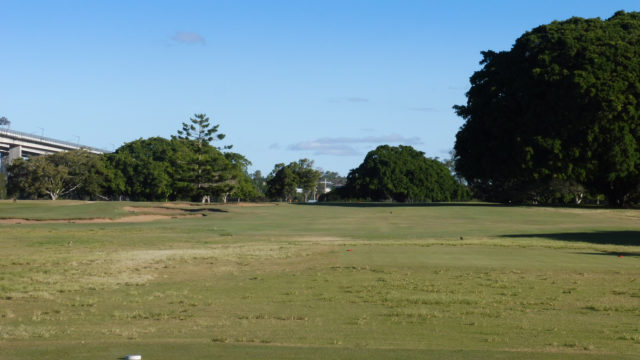
Hole 10 – 458 meter par 5
To start the second loop is the shortest and easiest par 5, with a slight left kink in the fairway. Three bunkers are at driving distance to the left, with a large fig tree narrowing the fairway opposite the last fairway trap.
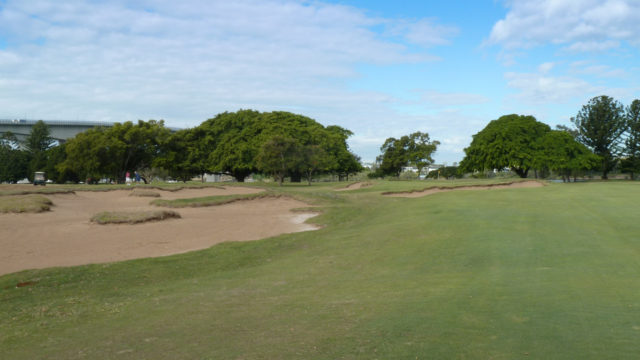
Approach to the 10th green
A waste area and further bunkers are to the left for the second shot. As the green angles away to the right, with a narrow bunker beside the green guarding that side, playing close to the waste offers the best approach. The green has some slight contours with a small drop off at the rear of the complex. Playing the first shot is more about target golf, but from the second onward the hole comes alive. Like many of the holes on the course, playing close to the edge of the fairway, where risk is greatest, will offer the best approach line.
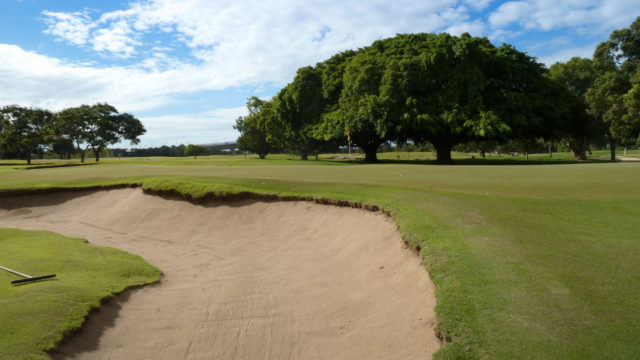
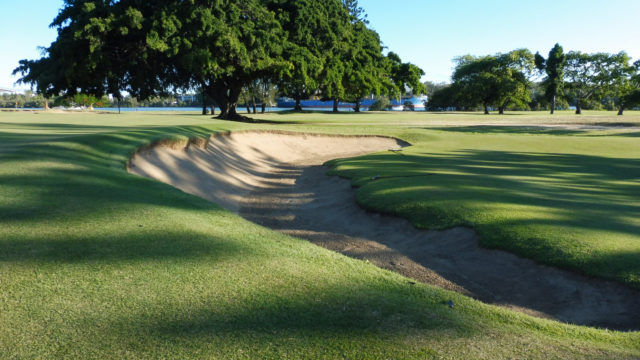
10th greenside bunker 2012 on left and 2017 on right
I had read after my first visit, comments on forums discussing channels in the bunkers. To be honest I could not understand what they were referring to. On my second visit this become very apparent and one particular case was the greenside bunker on the 10th hole. Five years after my first visit you can quite easily see the bottom has become a channel and much deeper than it was previously. This restricts the backswing, almost to the point that one cannot be made. I guess partially this is due to width of the bunkers to start with.
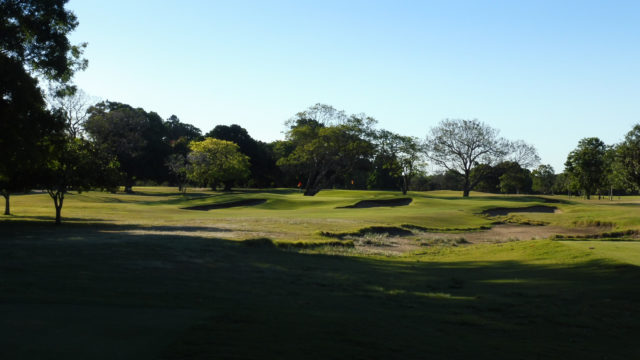
Hole 11 – 156 meter par 3
Moving to a mid length hole, is the hardest index par 3 on the course. There is a bit going on here, some eye candy, like the wast running along the right, but others which require your attention. In particular the four bunkers around the green.
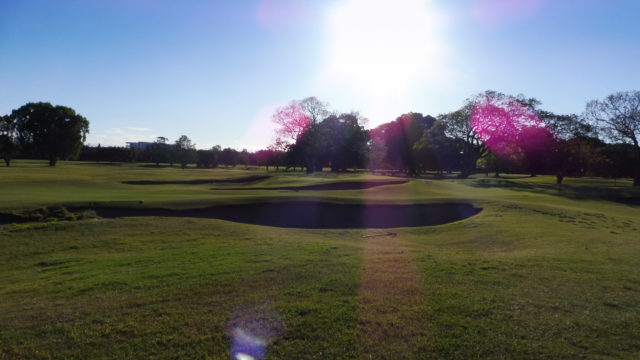
Looking across at the 11th green
The green is quite wide, but fairly shallow. Finding the correct portion is critical or a very long putt over strong slopes maybe required. There are a few openings between the traps to bring the ball in, but with a false front, running the ball in is not an option. Good testing hole, especially for the flat stick.
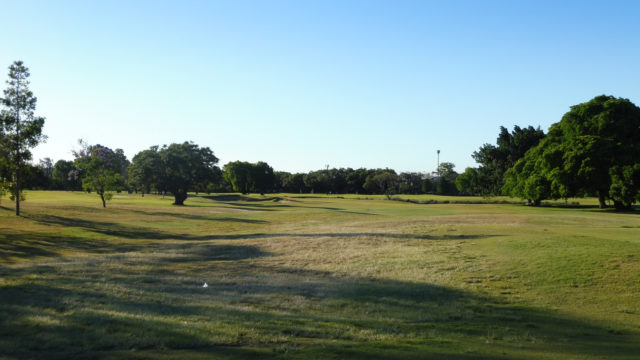
Hole 12 – 292 meter par 4
One of my favourite holes is the equal shortest par 4. Playing with a dogleg left, it is easy to find yourself in trouble if taking on too much or not executing correctly. Water is on the outside of the turn, where ample space is available to land the tee shot, but this leaves a bad angle to the green. Fairway bunkers to the left are quite long, but playing close to these will open up the green and most of its pin positions.
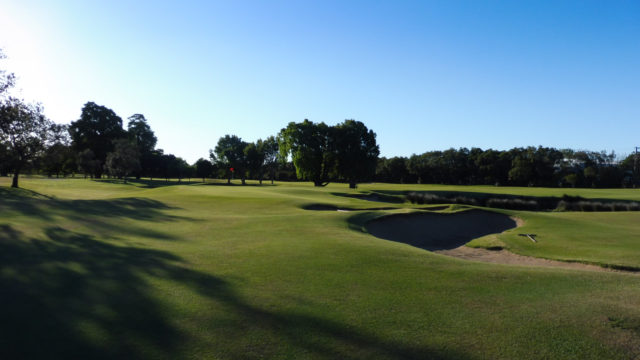
View of the 12th green
Further central bunkers are short of the green, with a small landing area to their left. Finding yourself here leaves and easy pitch into the elevated green. The putting surface has some strong contours. Finding yourself on the wrong side of these will leave a difficult, but interesting putt. So much to like on this hole, the strategic lines from the tee to green, along with the testing green.
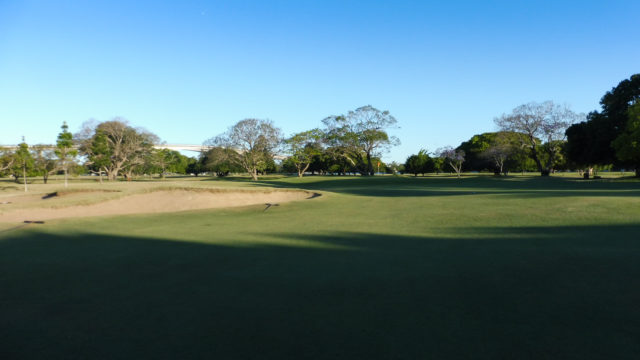
Hole 13 – 370 meter par 4
Heading in the opposite direction is this mid-long par 4, which dog legs right. A very wide and open fairway awaits, although there is one small bunker sitting on the right. Playing close to this leaves an ideal line into the green. If the safer left area of the fairway is found, a carry over bunkers short of the green is required.
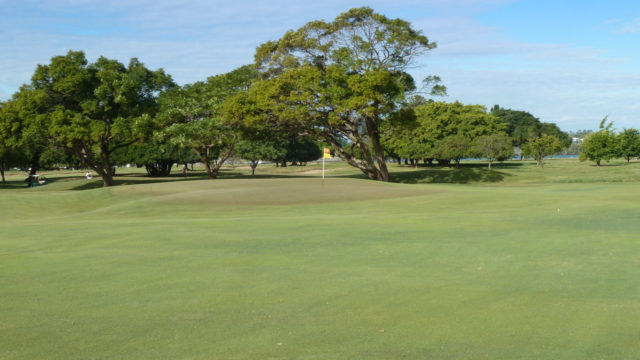
Bunker less 13th green
This is the first of two holes on the course, where no green side traps are found. Instead, this long narrow green, relies on strong contouring for defence. These are both on the green surrounds, with a swale to the left and steep run off at the rear, along with those on the putting surface, some of which help the ball to leave the green if not hit correctly. Simple yet very effective design. The green complex is just that, complex.
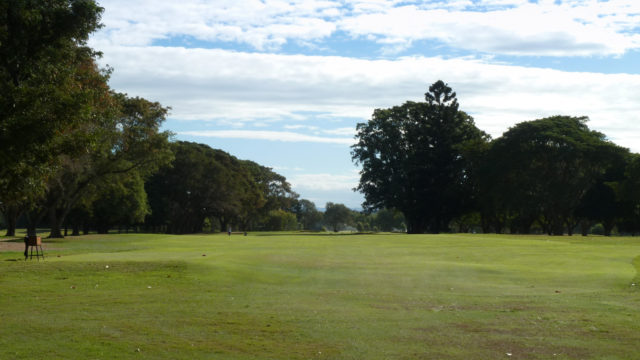
Hole 14 – 408 meter par 4
The longest par 4 on the course is also the most heavily wooded. With a slight kink right, there is ample fairway to land a tee shot, but the driving area narrows dramatically where trees encroach from the right. Finding this gap is critical to allows a clear shot to the green.
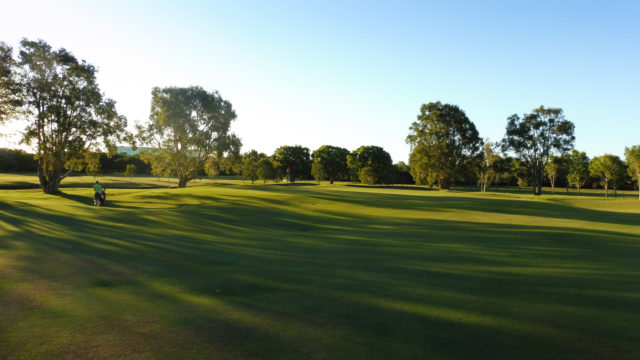
View of the 14th green
A bunker is found either side of the fairway in the second section, although would only come into play for shorter hitters or those who have found trouble off the tee. The fairway falls away before rising to the elevated green. The green is wide open at the front allowing the ball to be run in. All the trouble located at the sides and rear, which includes three traps and water. Quite different to the rest of the holes on the course, but well thought out design, taking into consideration the length.
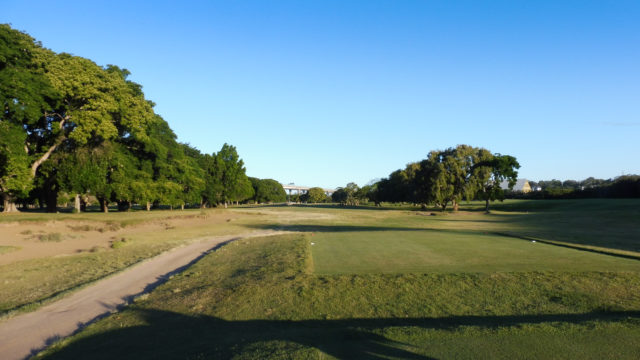
Hole 15 – 480 meter par 5
Heading back towards the Brisbane River is this long par 5. Water runs down the right of the fairway, but of more interest is that the fairway center line bunkers. The first leaves a wider gap to its right side than the left, but main consideration is where to position yourself to land the second shot.
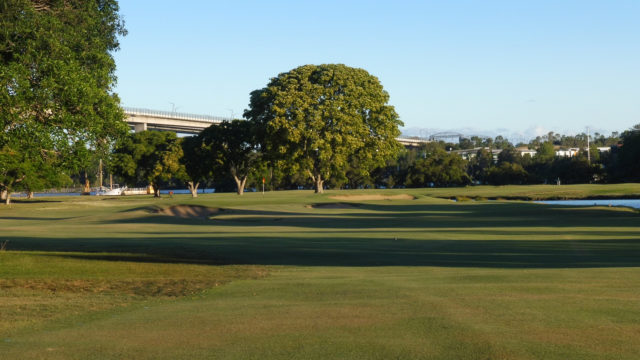
Approach from the 15th fairway
Placement of the second shot is much more critical. With the green angling slightly away to the right, finding the left portion of the fairway, beside the second group of center line bunkers.
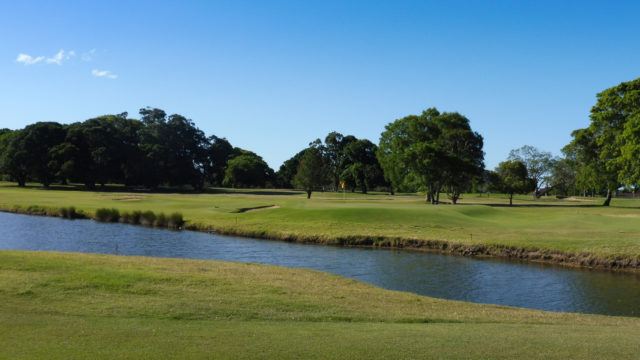
View of 15th green from 6th hole
The push up green integrates well at the front, but shaping could see the ball run off either side, if approaching from the right. A trap further up this side is more towards the rear. Subtle contours on the green, make this almost a two tiered green. Nice hole to play which requires some thought tee to green. A lot of people are not fans of bunkers in the center, but these really add character, along with increasing the strategy available.
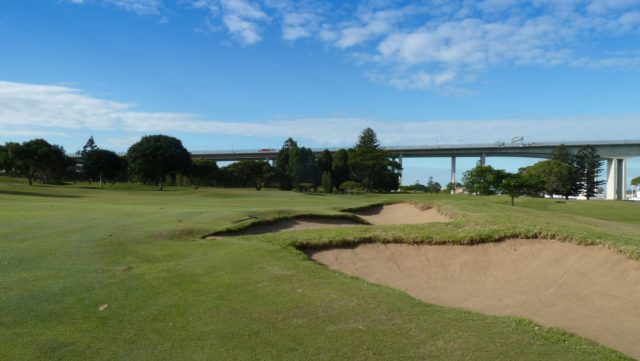
Hole 16 – 340 meter par 4
Playing in an easterly direction, this mid length par 4 has a dog leg left. A waste area is found to the right, encroaching across the hole, but short of the fairway. Two fairway traps to the right are the ideal line, landing close will allow an easier approach.
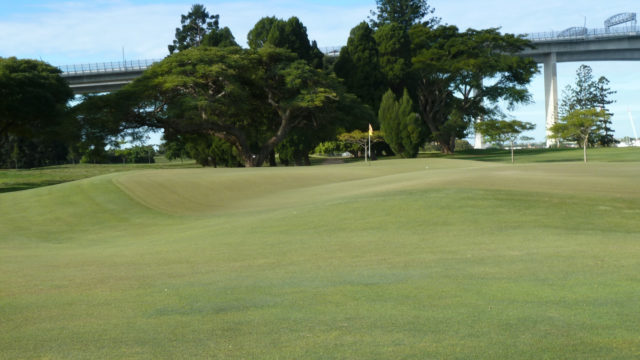
Strong Contours on the 16th green
The green complex on the 16th probably has the strongest contours of any on the course. A large hollow through the middle, which is much more severe to the left, almost makes this a Biarritz style green. Finding the wrong side here will leave an interesting chip or putt. Such an fascinating complex you could spend hours here experimenting.
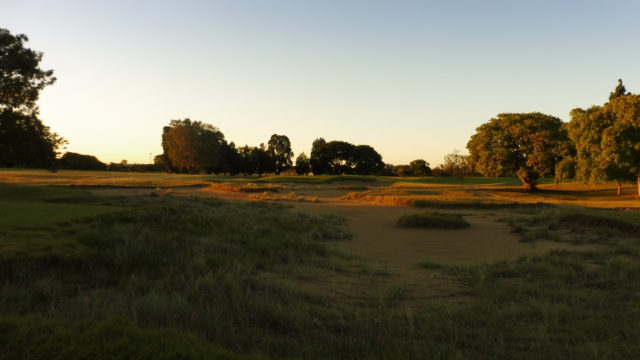
Hole 17 – 125 meter par 3
Coming to the penultimate hole, is the shortest on the course. This par 3 requires a carry over a waste area, which becomes a bunker in front of the green. This continues around the right side of the hole, leading to a more traditional bunker at the right rear.
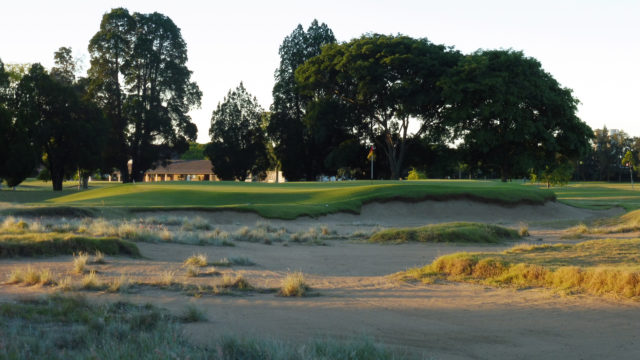
Waste area before the 17th green
Sitting quite elevated, the green has plenty of short grass, from the front left, around to the rear, ideal place to miss if the pin is on the opposite side. With two tiers the putting surface may leave a testing shot. Testing hole, even with its short length that will leave you laughing or crying.
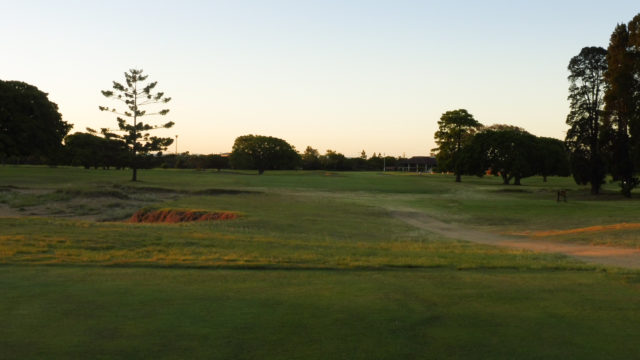
Hole 18 – 388 meter par 4
Finishing the round is this long par 4. A waste area is found between the tee and fairway. With the fairway joining the 1st and 10th holes, there is a lot of room to land the ball. But also a lot of bunkers, which will affect short to long hitters. Traps on the left will be in play for shorter and medium hitters, with this side allowing a clearer shot to rear pin positions. A center bunker and those to the right further along, will be in play for longer hitters. This side opens the green to the front and mid sections.
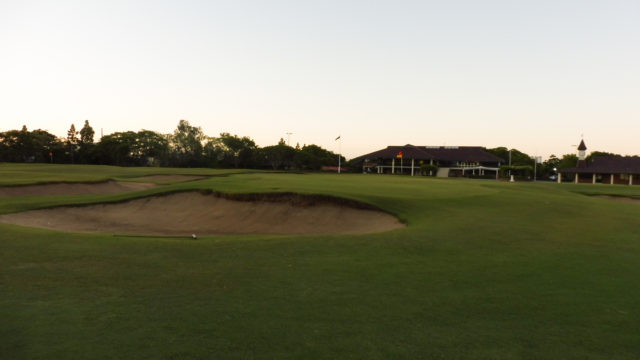
View of the 18th green
Bunkers pretty much surround this green, although the front right has an opening to run the ball in. Sitting slightly elevated the green angles away to the right and is quite long. Sloping slightly from front to rear, will make it slightly more difficult to hold the green. Tough finishing hole, but one that allows a few different strategies to be employed. All of these offer some risk verse reward component.
Looking at the course makeup:
- Hole Directions – There was a some variety allowing for conditions to have wide ranging effects during play. A vast majority of holes had either an northerly or easterly facing direction. No holes faced directly south west and direct north or south were minimal. There was a decent balance of directional change between the two nines, although on the back almost fifty percent played north west.
- Hole Lengths – Royal Queensland Golf Club is your traditional par 72 with 4 par 3, 4 par 5 and 10 par 4 holes. Par three holes had a good variance in distance, from short to long, the majority in mid length. Par four holes ranged from short to long with the majority being either mid or long length. Par 5 holes ranged from mid to long in length, with the majority being long. The par types were very well balanced over both the front and back nine along with the lengths played
- Hole Layout – There was an almost perfect mixture in how the holes played, with an even number of left and right turns, where two shots or more were required to reach the green. These were also well balanced between the front and back nine
Conditions on the course were generally good. Tees had regular rotation and were generally flat. Fairways overall were very good, however a few patches of dead grass had been found throughout the course. I was informed this was due to some of the water and its impurities. Bunkers, generally the greens were in good condition, however sand was inconsistent. Sometimes very firm and at others quite soft. The biggest issues with some of the narrower bunkers, was the channeling affect where they had depressed since first being built, restricting or in some cases preventing a back swing. Regular maintenance had been carried out five weeks before my visit. A light sanding had been carried out since, but did not really have much affect. There were signs on some of the greens of damage, with patches having been laid down on a few edges, but not yet fully integrated with the surrounding grass.
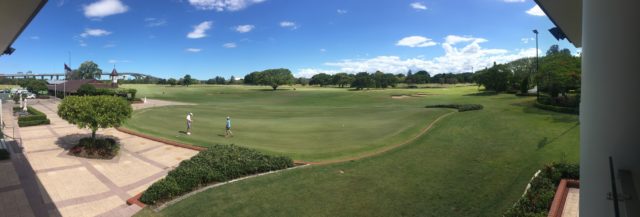
Panoramic view from the Clubhouse
In summary I was glad for a revisit to Royal Queensland Golf Club. After the first in 2012, I walked away thinking about how flat the land was, not really impressed with the golf course. Five years later and with a lot more golf architecture knowledge, the course was seen in a totally different way. Yes the land was still flat and not overly exciting, but the routing utilises every available space, yet still leaves plenty of room for each hole. There are clear strategies on a majority of the holes, keeping your attention. This certainly helps to distract from the fact it is not the best golf terrain. Having a lack of long fairway rough is really overlooked and quite refreshing really. The natural sandy base that the course is built on is utlised well as a substitute. Having plenty of short grass areas around the green allows the imagination to run wild on how to play the ball, putt, bump and run or lob when really required.
So my usual question on whether I would return or not. Most definitely yes. With every visit more subtleties in the course design are learnt, allowing for more enjoyable play.
How to play at Royal Queensland:
1. Be invited by a member
2. Be an interstate or overseas visitor who is a member of a golf club
I played the course as an interstate visitor.

